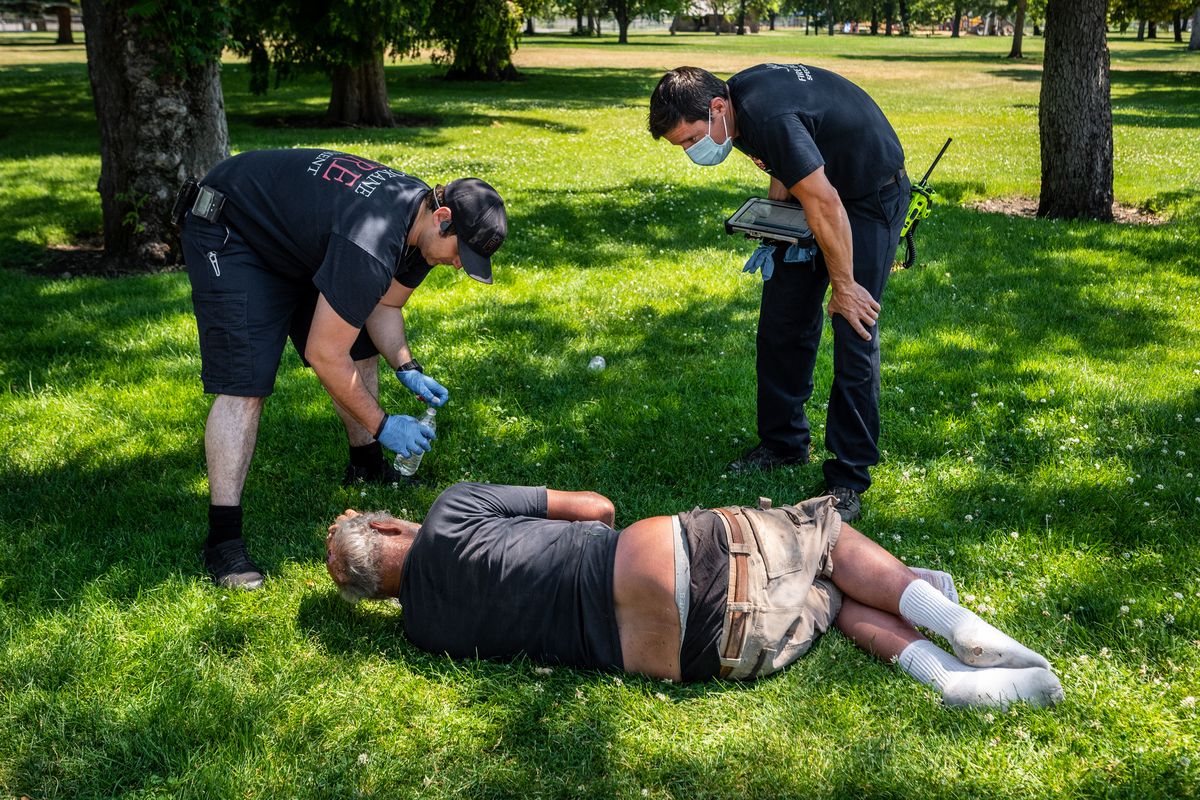‘The heat just amplifies any problem’: Spokane Fire Department’s special medical unit kept busy as heat rages

Less than 2 minutes after the Spokane Fire Department’s Alternative Response Unit pulled into Station 1 on Tuesday afternoon, the next call came in.
“This is the busiest rig in the city,” Lt. Gabe Mills said from the passenger’s seat.
The Alternative Response Units are dispatched to low-priority medical calls, and they have been busy during Spokane’s historic heat wave this week. ARU’s often see people who are dehydrated or have heatstroke, among other conditions, Mills said.
On Tuesday, a pizza delivery driver reported a man lying in the grass at the intersection of Superior Street and Mission Avenue. The ARU was dispatched at about 1:15 p.m. and arrived a few minutes later.
Firefighter Sean Condon got out of the truck and headed to check on the man in his 60s lying in the grass in the more than 100-degree heat, surrounded by a couple of water bottles, snacks and a bottle of alcohol.
Condon asked the man how he was feeling and if he needed help or wanted to go to the hospital. The man didn’t want help and was able to quickly and clearly respond to the firefighter’s questions, so they made him drink some water before closing out the call.
“That is basically the reason this rig is in service,” Mills said of the call.
While this patient didn’t want to be transported to the hospital, most people the firefighters see do want to go get checked out, receive fluids, cool off and maybe get a meal.
Firefighters evaluate patients to make sure they’re alert and oriented if they refuse a trip to the hospital, Mills said.
While an increase in heat calls during Spokane’s warmer months is common, the record-breaking heat wave Spokane is experiencing this week has made Station 1 extra busy, Capt. Pat Walsh said. The station downtown at 44 W. Riverside Ave. often responds to calls to help homeless people stuck out in the heat, Walsh said.
“Our big focus down here is the unhoused and just their lack of ability to get fluids and find shelter,” Walsh said. “The heat just amplifies any problem.”
The station has already seen an increase in heat-related calls, and some that don’t come in as heat-related turn out to be, Walsh said.
“When you get into the root of the problem, and it is definitely exposure,” Walsh said.
Just a few minutes after the ARU pulled back into the fire station, a park ranger reported a man had a seizure at the cooling center at the Looff Carrousel in Riverfront Park. When the ARU arrived a few minutes later, the man was inside and and lying on the floor with a cool rag on his face.
An ambulance arrived and the paramedics and firefighters checked the patient’s vitals. He said the seizure was normal for him, brought on by stress and the heat.
The patient’s friend talked to the firefighters over the sound of the carousel’s music in the next room. After getting checked out, the patient said he didn’t want to go to the hospital, so the firefighters gave his friend some instant ice packs and headed back to the station.
When they arrived, their fellow firefighters were fixing a late lunch, trying to stay fed and hydrated on their long shift. In the extreme heat, they have to be extra careful to take care of themselves, Walsh said. He encourages the firefighters he supervises on his shift to hydrate up to two days before their shift. Under more than 80 pounds of gear worn on fire calls, crews feel the effects of the heat within minutes, he said.
Even in the firehouse, the air conditioning can’t quite keep up with the record-breaking temperatures outside. Despite the long hours, back-to-back calls and sweltering heat, Condon said he’s honored to serve his community.
“It’s the greatest job in the world,” Condon said. “It’s more fun than work, if done right.”
Minutes later, firefighters loaded up and headed out to yet another heat-related call, expecting a long night ahead.